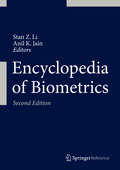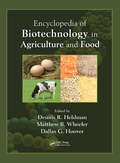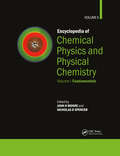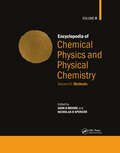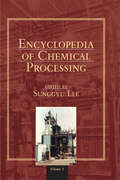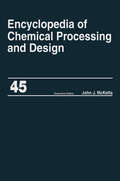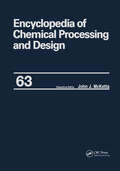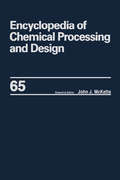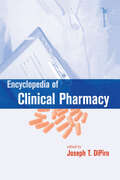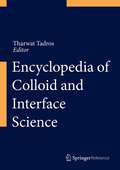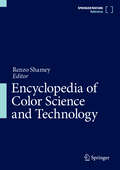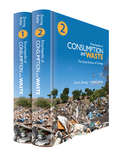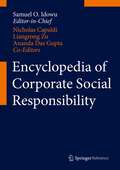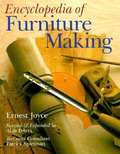- Table View
- List View
Encyclopedia of Biometrics
by Stan Z. Li Anil K. JainThis encyclopedia provides a comprehensive reference to topics in biometrics including concepts, modalities, algorithms, devices, systems, security, performance testing, applications and standardization. With an A-Z format and over 1400 entries, it provides easy access to relevant information on all aspects of biometrics for those seeking entry into this broad field. Entries are written by experts in biometrics and related fields. Each entry includes a definition, key words, list of synonyms, list of related entries, illustration(s), applications and a bibliography. Most entries include useful literature references providing the reader with a portal to more detailed information. Comprehensive and tutorial, the Encyclopedia of Biometrics, 2nd Edition is a practical resource for experts in the field and professionals interested in aspects of biometrics.
Encyclopedia of Biophysics
by Gordon Roberts European Biophysical Societies' AssociationThe Encyclopedia of Biophysics is envisioned both as an easily accessible source of information and as an introductory guide to the scientific literature. It includes entries describing both Techniques and Systems. In the Techniques entries, each of the wide range of methods which fall under the heading of Biophysics are explained in detail, together with the value and the limitations of the information each provides. Techniques covered range from diffraction (X-ray, electron and neutron) through a wide range of spectroscopic methods (X-ray, optical, EPR, NMR) to imaging (from electron microscopy to live cell imaging and MRI), as well as computational and simulation approaches. In the Systems entries, biophysical approaches to specific biological systems or problems - from protein and nucleic acid structure to membranes, ion channels and receptors - are described. These sections, which place emphasis on the integration of the different techniques, therefore provide an inroad into Biophysics from a biological more than from a technique-oriented physical/chemical perspective. Thus the Encyclopedia is intended to provide a resource both for biophysicists interested in methods beyond those used in their immediate sub-discipline and for those readers who are approaching biophysics from either a physical or biological background.
Encyclopedia of Biotechnology in Agriculture and Food
by Dennis R. Heldman, Matthew B. Wheeler and Dallas G. HooverThe Encyclopedia of Biotechnology in Agriculture and Food provides users with unprecedented access to nearly 200 entries that cover the entire food system, describing the concepts and processes that are used in the production of raw agricultural materials and food product manufacturing. So that users can locate the information they need quickly without having to flip through pages and pages of content, the encyclopedia avoids unnecessary complication by presenting information in short, accessible overviews. Addresses Environmental Issues & Sustainability in the Context of 21st Century Challenges Edited by a respected team of biotechnology experts, this unrivaled resource includes descriptions and interpretations of molecular biology research, including topics on the science associated with the cloning of animals, the genetic modification of plants, and the enhanced quality of foods. It discusses current and future applications of molecular biology, with contributions on disease resistance in animals, drought-resistant plants, and improved health of consumers via nutritionally enhanced foods. Uses Illustrations to Communicate Essential Concepts & Visually Enhance the Text This one-of-a-kind periodical examines regulation associated with biotechnology applications—with specific attention to genetically modified organisms—regulation differences in various countries, and biotechnology’s impact on the evolution of new applications. The encyclopedia also looks at how biotechnology is covered in the media, as well as the biotechnology/environment interface and consumer acceptance of the products of biotechnology. Rounding out its solid coverage, the encyclopedia discusses the benefits and concerns about biotechnology in the context of risk assessment, food security, and genetic diversity. ALSO AVAILABLE ONLINE This Taylor & Francis encyclopedia is also available through online subscription, offering a variety of extra benefits for both researchers, students, and librarians, including: Citation tracking and alerts Active reference linking Saved searches and marked lists HTML and PDF format options For more information, visit Taylor & Francis Online or contact us to inquire about subscription options and print/online combination packages. US: (Tel) 1.888.318.2367 / (E-mail) e-reference@taylorandfrancis.com International: (Tel) +44 (0) 20 7017 6062 / (E-mail) online.sales@tandf.co.uk Dennis R. Heldman speaks about his work on the CRC Press YouTube Channel.
Encyclopedia of Chemical Physics and Physical Chemistry: Volume 1: Fundamentals
by John H Moore Nicholas D SpencerThe Encyclopedia of Physical Chemistry and Chemical Physics introduces possibly unfamiliar areas, explains important experimental and computational techniques, and describes modern endeavors. The encyclopedia quickly provides the basics, defines the scope of each subdiscipline, and indicates where to go for a more complete and detailed explanation. Particular attention has been paid to symbols and abbreviations to make this a user-friendly encyclopedia. Care has been taken to ensure that the reading level is suitable for the trained chemist or physicist. The encyclopedia is divided in three major sections: FUNDAMENTALS: the mechanics of atoms and molecules and their interactions, the macroscopic and statistical description of systems at equilibrium, and the basic ways of treating reacting systems. The contributions in this section assume a somewhat less sophisticated audience than the two subsequent sections. At least a portion of each article inevitably covers material that might also be found in a modern, undergraduate physical chemistry text. METHODS: the instrumentation and fundamental theory employed in the major spectroscopic techniques, the experimental means for characterizing materials, the instrumentation and basic theory employed in the study of chemical kinetics, and the computational techniques used to predict the static and dynamic properties of materials. APPLICATIONS: specific topics of current interest and intensive research.For the practicing physicist or chemist, this encyclopedia is the place to start when confronted with a new problem or when the techniques of an unfamiliar area might be exploited. For a graduate student in chemistry or physics, the encyclopedia gives a synopsis of the basics and an overview of the range of activities in which physical principles are applied to chemical problems. It will lead any of these groups to the salient points of a new field as rapidly as possible and gives pointers as to where to read about the topic in more detail.
Encyclopedia of Chemical Physics and Physical Chemistry: Volume 2: Methods
by John H Moore Nicholas D SpencerThe Encyclopedia of Physical Chemistry and Chemical Physics introduces possibly unfamiliar areas, explains important experimental and computational techniques, and describes modern endeavors. The encyclopedia quickly provides the basics, defines the scope of each subdiscipline, and indicates where to go for a more complete and detailed explanation. Particular attention has been paid to symbols and abbreviations to make this a user-friendly encyclopedia. Care has been taken to ensure that the reading level is suitable for the trained chemist or physicist. The encyclopedia is divided in three major sections: FUNDAMENTALS: the mechanics of atoms and molecules and their interactions, the macroscopic and statistical description of systems at equilibrium, and the basic ways of treating reacting systems. The contributions in this section assume a somewhat less sophisticated audience than the two subsequent sections. At least a portion of each article inevitably covers material that might also be found in a modern, undergraduate physical chemistry text. METHODS: the instrumentation and fundamental theory employed in the major spectroscopic techniques, the experimental means for characterizing materials, the instrumentation and basic theory employed in the study of chemical kinetics, and the computational techniques used to predict the static and dynamic properties of materials. APPLICATIONS: specific topics of current interest and intensive research.For the practicing physicist or chemist, this encyclopedia is the place to start when confronted with a new problem or when the techniques of an unfamiliar area might be exploited. For a graduate student in chemistry or physics, the encyclopedia gives a synopsis of the basics and an overview of the range of activities in which physical principles are applied to chemical problems. It will lead any of these groups to the salient points of a new field as rapidly as possible and gives pointers as to where to read about the topic in more detail.
Encyclopedia of Chemical Physics and Physical Chemistry: Volume 3: Applications
by John H Moore Nicholas D SpencerThe Encyclopedia of Physical Chemistry and Chemical Physics introduces possibly unfamiliar areas, explains important experimental and computational techniques, and describes modern endeavors. The encyclopedia quickly provides the basics, defines the scope of each subdiscipline, and indicates where to go for a more complete and detailed explanation. Particular attention has been paid to symbols and abbreviations to make this a user-friendly encyclopedia. Care has been taken to ensure that the reading level is suitable for the trained chemist or physicist. The encyclopedia is divided in three major sections: FUNDAMENTALS: the mechanics of atoms and molecules and their interactions, the macroscopic and statistical description of systems at equilibrium, and the basic ways of treating reacting systems. The contributions in this section assume a somewhat less sophisticated audience than the two subsequent sections. At least a portion of each article inevitably covers material that might also be found in a modern, undergraduate physical chemistry text. METHODS: the instrumentation and fundamental theory employed in the major spectroscopic techniques, the experimental means for characterizing materials, the instrumentation and basic theory employed in the study of chemical kinetics, and the computational techniques used to predict the static and dynamic properties of materials. APPLICATIONS: specific topics of current interest and intensive research.For the practicing physicist or chemist, this encyclopedia is the place to start when confronted with a new problem or when the techniques of an unfamiliar area might be exploited. For a graduate student in chemistry or physics, the encyclopedia gives a synopsis of the basics and an overview of the range of activities in which physical principles are applied to chemical problems. It will lead any of these groups to the salient points of a new field as rapidly as possible and gives pointers as to where to read about the topic in more detail.
Encyclopedia of Chemical Processing (Online)
by Sunggyu LeeThis second edition Encyclopedia supplies nearly 350 gold standard articles on the methods, practices, products, and standards influencing the chemical industries. It offers expertly written articles on technologies at the forefront of the field to maximize and enhance the research and production phases of current and emerging chemical manufacturing practices and techniques. This collecting of information is of vital interest to chemical, polymer, electrical, mechanical, and civil engineers, as well as chemists and chemical researchers.A complete reconceptualization of the classic reference series the Encyclopedia of Chemical Processing and Design, whose first volume published in 1976, this resource offers extensive A-Z treatment of the subject in five simultaneously published volumes, with comprehensive indexing of all five volumes in the back matter of each tome. It includes material on the design of key unit operations involved with chemical processes; the design, unit operation, and integration of reactors and separation systems; process system peripherals such as pumps, valves, and controllers; analytical techniques and equipment; and pilot plant design and scale-up criteria.This reference contains well-researched sections on automation, equipment, design and simulation, reliability and maintenance, separations technologies, and energy and environmental issues. Authoritative contributions cover chemical processing equipment, engineered systems, and laboratory apparatus currently utilized in the field. It also presents expert overviews on key engineering science topics in property predictions, measurements and analysis, novel materials and devices, and emerging chemical fields.ALSO AVAILABLE ONLINE This Taylor & Francis encyclopedia is also available through online subscription, offering a variety of extra benefits for both researchers, students, and librarians, including: Citation tracking and alerts Active reference linking Saved searches and marked lists HTML and PDF format options Contact Taylor and Francis for more information or to inquire about subscription options and print/online combination packages.US: (Tel) 1.888.318.2367; (E-mail) e-reference@taylorandfrancis.comInternational: (Tel) +44 (0) 20 7017 6062; (E-mail) online.sales@tandf.co.uk
Encyclopedia of Chemical Processing and Design: Volume 31 - Natural Gas Liquids and Natural Gasoline to Offshore Process Piping: High Performance Alloys (Chemical Processing And Design Encyclopedia Ser.)
by John J. McKetta William A. Cunningham""Written by engineers for engineers (with over 150 International Editorial Advisory Board members),this highly lauded resource provides up-to-the-minute information on the chemical processes, methods, practices, products, and standards in the chemical, and related, industries.
Encyclopedia of Chemical Processing and Design: Volume 37 - Pipeline Flow: Basics to Piping Design (Chemical Processing And Design Encyclopedia Ser.)
by John J. McKetta; William A. CunninghamWritten by engineers for engineers (with over 150 International Editorial Advisory Board members),this highly lauded resource provides up-to-the-minute information on the chemical processes, methods, practices, products, and standards in the chemical, and related, industries.
Encyclopedia of Chemical Processing and Design: Volume 45 - Project Progress Management to Pumps (Chemical Processing And Design Encyclopedia Ser.)
by John J. McKetta""Written by engineers for engineers (with over 150 International Editorial Advisory Board members),this highly lauded resource provides up-to-the-minute information on the chemical processes, methods, practices, products, and standards in the chemical, and related, industries.
Encyclopedia of Chemical Processing and Design: Volume 48 - Residual Refining and Processing to Safety: Operating Discipline (Chemical Processing And Design Encyclopedia Ser.)
by John J. McKetta William A. Cunningham""Written by engineers for engineers (with over 150 International Editorial Advisory Board members),this highly lauded resource provides up-to-the-minute information on the chemical processes, methods, practices, products, and standards in the chemical, and related, industries.
Encyclopedia of Chemical Processing and Design: Volume 63 - Viscosity: Heavy Oils to Waste: Hazardous: Legislation (Chemical Processing and Design Encyclopedia)
by John J. McKetta Guy E. WeismantelThis is volume 63 of the Encyclopaedia of Chemical Processing and Design and includes Viscosity, Heavy Oils to Waste, Hazardous, and Legislation.
Encyclopedia of Chemical Processing and Design: Volume 65 -- Waste: Nuclear Reprocessing and Treatment Technologies to Wastewater Treatment: Multilateral Approach (Chemical Processing And Design Encyclopedia Ser.)
by John J. McKetta Guy E. Weismantel""Waste. Nuclear Reprocessing and Treatment Technologies to Waste, Solid, Trash Facts
Encyclopedia of Clinical Neuropsychology
by Bruce Caplan Jeffrey Kreutzer John DelucaThis encyclopedia serves as a unified, comprehensive reference for professionals involved in the diagnosis, evaluation, and rehabilitation of adult patients and children with neuropsychological disorders. It addresses psychological, psychosocial, and psychiatric aspects of an array of neurological disorders, emphasizing treatment and rehabilitation, not just assessment and diagnosis.
Encyclopedia of Clinical Pharmacy
by Joseph T. DiPiroThe Encyclopedia of Clinical Pharmacy is a valuable resource for today's clinical pharmacist and pharmacotherapist. Over 200 researchers and practitioners provide ready access to more than 5,000 primary literature citations and hard-to-find research on: Gene therapy Health service delivery models Best practices documents Pharmaceutical software development Legal controversies, ethical issues, and court rulings Drug dosing and electronic prescription Post-marketing surveillance Generic equivalency Quality management procedures Educational and training programs Compiling expertise and recommendations from the American College of Clinical Pharmacy and the American Society of Health-System Pharmacists, the Encyclopedia unravels the increasing complexity of pharmacotherapy, the problems of medication-related morbidity and mortality, and the impact that clinically empowered pharmacists have on assuring safe and effective pharmaceutical care for patients.
Encyclopedia of Colloid and Interface Science
by Tharwat TadrosAn authoritative and comprehensive reference relevant to all scientists and engineers in the field. This encyclopedia not only helps chemistry, materials science and physics researchers to understand the principles, but also provides practicing engineers with the necessary information for implementing practical applications, such as Food and agrochemicals Polymers and ceramics Cosmetics and detergents Paints and coatings Pharmaceuticals and drug delivery In addition, the encyclopedia is an important reference for industrial chemists and chemical engineers faced with a multitude of industrial systems of a colloidal nature. As wide as the range of applications that colloid and interface science has is the range of scientific disciplines that contribute to research and development in this field. These encompass chemistry, physics, biology and mathematics as well as nanoscience and nanotechnology. The encyclopedia provides easy-to-digest information for meeting these interdisciplinary challenges. While providing numerous concise definitions of key terms, the encyclopedia also features more than forty in-depth essays on topics ranging from Agrochemical Formulations to Zeta Potential. All entries are cross-referenced and include selected references to original literature as well as synonyms.
Encyclopedia of Color Science and Technology
by Renzo ShameyThis fully revised and expanded 2nd edition provides a single authoritative resource describing the concepts of color and the application of color science across research and industry. Significant changes for the 2nd edition include: New and expanded sections on color engineeringMore entries on fundamental concepts of color science and color termsMany additional entries on specific materialsFurther material on optical concepts and human visual perceptionAdditional articles on organisations, tools and systems relevant to colorA new set of entries on 3D presentation of color In addition, many of the existing entries have been revised and updated to ensure that the content of the encyclopedia is current and represents the state of the art. The work covers the full gamut of color: the fundamentals of color science; the physics and chemistry; color as it relates to optical phenomena and the human visual system; and colorants and materials. The measurement of color is described through entries on colorimetry, color spaces, color difference metrics, color appearance models, color order systems and cognitive color. The encyclopedia also has extensive coverage of applications throughout industry, including color imaging, color capture, display and printing, and descriptions of color encodings, color management, processing color and applications relating to color synthesis for computer graphics are included. The broad scope of the work is illustrated through entries on color in art conservation, color and architecture, color and education, color and culture, and biographies of some of the key figures involved in color research throughout history. With over 250 entries from color science researchers across academia and industry, this expanded 2nd edition of the Encyclopedia of Color Science and Technology remains the most important single resource in color science.
Encyclopedia of Consumption and Waste: The Social Science of Garbage
by Professor Carl A. Zimring Dr William L. RathjeArchaeologists and anthropologists have long studied artifacts of refuse from the distant past as a portal into ancient civilizations, but examining what we throw away today tells a story in real time and becomes an important and useful tool for academic study. Trash is studied by behavioral scientists who use data compiled from the exploration of dumpsters to better understand our modern society and culture. Why does the average American household send 470 pounds of uneaten food to the garbage can on an annual basis? How do different societies around the world cope with their garbage in these troubled environmental times? How does our trash give insight into our attitudes about gender, class, religion, and art? The Encyclopedia of Consumption and Waste explores the topic across multiple disciplines within the social sciences and ranges further to include business, consumerism, environmentalism, and marketing to comprise an outstanding reference for academic and public libraries.
Encyclopedia of Corporate Social Responsibility
by Nicholas Capaldi Samuel O Idowu Ananda Das Gupta Liangrong ZuThe role of Corporate Social Responsibility in the business world has developed from a fig leaf marketing front into an important aspect of corporate behavior over the past several years. Sustainable strategies are valued, desired and deployed more and more by relevant players in many industries all over the world. Both research and corporate practice therefore see CSR as a guiding principle for business success. The "Encyclopedia of Corporate Social Responsibility" has been conceived to assist researchers and practitioners to align business and societal objectives. All actors in the field will find reliable and up to date definitions and explanations of the key terms of CSR in this authoritative and comprehensive reference work. Leading experts from the global CSR community have contributed to make the "Encyclopedia of Corporate Social Responsibility" the definitive resource for this field of research and practice.
Encyclopedia of Cosmology: Historical, Philosophical, and Scientific Foundations of Modern Cosmology (Routledge Revivals)
by Norriss S. HetheringtonThe Encyclopedia of Cosmology, first published in 1993, recounts the history, philosophical assumptions, methodological ambiguities, and human struggles that have influenced the various responses to the basic questions of cosmology through the ages, as well as referencing important scientific theories. Just as the recognition of social conventions in other cultures can lead to a more productive perspective on our own behaviour, so too a study of the cosmologies of other times and places can enable us recognise elements of our own cosmology that might otherwise pass as inevitable developments. Apart from modern natural science, therefore, this volume incorporates brief treatments of Native American, Cave-Dweller, Chinese, Egyptian, Islamic, Megalithic, Mesopotamian, Greek, Medieval and Copernican cosmology, leading to an appreciation of cosmology as an intellectual creation, not merely a collection of facts. It is a valuable reference tool for any student or academic with an interest in the history of science and cosmology specifically.
Encyclopedia of Dietary Supplements
by Mark Levine Gordon M. Cragg Paul M. Coates Joel Moss Marc R. Blackman Joseph M. Betz Jeffrey D. WhiteEncyclopedia of Dietary Supplements presents peer-reviewed, objective entries that rigorously examine the most significant scientific research on basic chemical, preclinical, and clinical data. Designed for healthcare professionals, researchers, and health-conscious consumers, it presents evidence-based information on the major vitamin and mineral micronutrients, herbs, botanicals, phytochemicals, and other bioactive preparations.Supplements covered include: Vitamins, beta-carotene, niacin, and folate Omega-3 and omega-6 fatty acids, isoflavones, and quercetin Calcium, copper, iron, and phosphorus 5-hydroxytryptophan, glutamine, and L-arginine St. John's Wort, ginkgo biloba, green tea, kava, and noni Androstenedione, DHEA, and melatonin Coenzyme Q10 and S-adenosylmethionine Shiitake, maitake, reishi, and cordiceps With nearly 100 entries contributed by renowned subject-specific experts, the book serves as a scientific checkpoint for the many OTC supplements carried in today's nutritional products marketplace.Also Available OnlineThis Taylor & Francis encyclopedia is also available through online subscription, offering a variety of extra benefits for researchers, students, and librarians, including: Citation tracking and alerts Active reference linking Saved searches and marked lists HTML and PDF format optionsContact Taylor and Francis for more information or to inquire about subscription options and print/online combination packages.US: (Tel) 1.888.318.2367; (E-mail) e-reference@taylorandfrancis.comInternational: (Tel) +44 (0) 20 7017 6062; (E-mail) online.sales@tandf.co.uk
Encyclopedia of Early Modern Philosophy and the Sciences
by Justin E. Smith Angus Gowland Martin Lenz Ruth Hagengruber Zvi Biener Gideon Manning Marius Stan Delphine Bellis Hiro Hirai Silvia Manzo Cesare Pastorino Kirsten WalshThis Encyclopedia offers a fresh, integrated and creative perspective on the formation and foundations of philosophy and science in European modernity. Combining careful contextual reconstruction with arguments from traditional philosophy, the book examines methodological dimensions, breaks down traditional oppositions such as rationalism vs. empiricism, calls attention to gender issues, to ‘insiders and outsiders’, minor figures in philosophy, and underground movements, among many other topics. In addition, and in line with important recent transformations in the fields of history of science and early modern philosophy, the volume recognizes the specificity and significance of early modern science and discusses important developments including issues of historiography (such as historical epistemology), the interplay between the material culture and modes of knowledge, expert knowledge and craft knowledge. This book stands at the crossroads of different disciplines and combines their approaches – particularly the history of science, the history of philosophy, contemporary philosophy of science, and intellectual and cultural history. It brings together over 100 philosophers, historians of science, historians of mathematics, and medicine offering a comprehensive view of early modern philosophy and the sciences. It combines and discusses recent results from two very active fields: early modern philosophy and the history of (early modern) science. Editorial BoardEDITORS-IN-CHIEFDana Jalobeanu University of Bucharest, RomaniaCharles T. Wolfe Ghent University, BelgiumASSOCIATE EDITORSDelphine Bellis University Nijmegen, The NetherlandsZvi Biener University of Cincinnati, OH, USAAngus Gowland University College London, UKRuth Hagengruber University of Paderborn, GermanyHiro Hirai Radboud University Nijmegen, The NetherlandsMartin Lenz University of Groningen, The NetherlandsGideon Manning CalTech, Pasadena, CA, USASilvia Manzo University of La Plata, ArgentinaEnrico Pasini University of Turin, ItalyCesare Pastorino TU Berlin, GermanyLucian Petrescu Université Libre de Bruxelles, BelgiumJustin E. H. Smith University de Paris Diderot, FranceMarius Stan Boston College, Chestnut Hill, MA, USAKoen Vermeir CNRS-SPHERE + Université de Paris, FranceKirsten Walsh University of Calgary, Alberta, Canada
Encyclopedia of Emulsion Technology: Volume 4 (Emulsion Technology Encyclopedia)
by Paul BecherThis volume extends the discussions of basic theory and applications featured in volumes 1-3 of this series. It includes details on emulsion stability and emulsification; an examination on the effect of added polymers on emulsion rheology; findings on the role of repulsive forces in aqueous solubility, micelle stability, micro-emulsion formation, and phase separation; and a model for microemulsions.
Encyclopedia of Furniture Making
by Alan Peters Ernest JoyceHobbyist and professional will find this book to be a handy reference on woodworking in general and furniture making in particular.
Encyclopedia of GIS
by Shashi Shekhar Hui XiongThe Encyclopedia of GIS provides a comprehensive and authoritative guide, contributed by experts and peer-reviewed for accuracy, and alphabetically arranged for convenient access. The entries explain key software and processes used by geographers and computational scientists. Major overviews are provided for nearly 200 topics: Geoinformatics, Spatial Cognition, and Location-Based Services and more. Shorter entries define specific terms and concepts. The reference will be published as a print volume with abundant black and white art, and simultaneously as an XML online reference with hyperlinked citations, cross-references, four-color art, links to web-based maps, and other interactive features.
